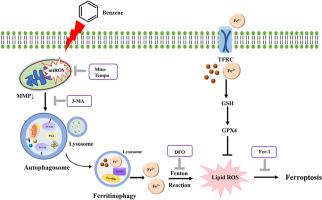铁下垂通过线粒体ros -铁蛋白吞噬途径参与苯诱导的血液毒性
IF 7.3
2区 环境科学与生态学
Q1 ENVIRONMENTAL SCIENCES
引用次数: 0
摘要
苯,一种常见的环境污染物,显著影响造血系统。虽然苯的毒性已被充分记载,但所涉及的确切分子机制仍不清楚。本研究旨在探讨铁下垂在苯诱导的血液毒性中的作用并揭示其潜在机制。暴露于苯的大鼠外周血细胞计数减少,血清铁浓度升高,骨髓细胞中与自噬和铁凋亡相关的蛋白质表达增加。此外,抑制苯暴露大鼠的自噬可以减轻体重减轻、外周血细胞异常、铁调节失调和铁下垂信号激活。为了进一步研究细胞机制,我们进行了体外实验,发现苯代谢物对苯二酚(HQ)可引起JHP细胞的铁凋亡并破坏自噬功能。同时,自噬抑制剂3-甲基腺嘌呤(3-MA)减轻了这些不良反应。此外,HQ诱导JHP细胞线粒体损伤,表现为线粒体膜电位(MMP)下降和线粒体活性氧(mtROS)增加。综上所述,我们的研究结果表明mtros依赖性自噬参与了苯诱导的铁凋亡,为苯诱导的血液毒性的发病机制和潜在的干预措施提供了重要的理论基础。本文章由计算机程序翻译,如有差异,请以英文原文为准。


Ferroptosis is involved in the benzene-induced hematotoxicity via mitochondrial ROS-ferritinophagy pathway
Benzene, a common environmental contaminant that significantly impacts the hematopoietic system. Although benzene toxicity has been well documented, the exact molecular mechanisms involved remain unclear. This study aimed to explore the role of ferroptosis in benzene-induced hematotoxicity and uncover the underlying mechanisms. Rats exposed to benzene exhibited reduced peripheral blood cell counts, elevated serum iron concentrations, and increased expression of proteins associated with autophagy and ferroptosis within their bone marrow (BM) cells. In addition, inhibition of autophagy in benzene-exposed rats alleviated weight loss, peripheral blood cell abnormalities, iron dysregulation, and ferroptosis signaling activation. To further investigate the cellular mechanisms, we conducted in vitro experiments in which the benzene metabolite hydroquinone (HQ) was found to elicit ferroptosis and disrupt autophagy functionality in JHP cells. Meanwhile, the autophagy inhibitor 3-methyladenine (3-MA) alleviated these adverse effects. Additionally, HQ induced damage to mitochondria in JHP cells, as evidenced by a decline in mitochondrial membrane potential (MMP) and an increase in mitochondrial reactive oxygen species (mtROS). Collectively, our results demonstrate that mtROS-dependent autophagy participates in ferroptosis induced by benzene, providing a significant theoretical foundation for the pathogenesis and potential interventions underlying benzene-induced hematotoxicity.
求助全文
通过发布文献求助,成功后即可免费获取论文全文。
去求助
来源期刊

Environmental Pollution
环境科学-环境科学
CiteScore
16.00
自引率
6.70%
发文量
2082
审稿时长
2.9 months
期刊介绍:
Environmental Pollution is an international peer-reviewed journal that publishes high-quality research papers and review articles covering all aspects of environmental pollution and its impacts on ecosystems and human health.
Subject areas include, but are not limited to:
• Sources and occurrences of pollutants that are clearly defined and measured in environmental compartments, food and food-related items, and human bodies;
• Interlinks between contaminant exposure and biological, ecological, and human health effects, including those of climate change;
• Contaminants of emerging concerns (including but not limited to antibiotic resistant microorganisms or genes, microplastics/nanoplastics, electronic wastes, light, and noise) and/or their biological, ecological, or human health effects;
• Laboratory and field studies on the remediation/mitigation of environmental pollution via new techniques and with clear links to biological, ecological, or human health effects;
• Modeling of pollution processes, patterns, or trends that is of clear environmental and/or human health interest;
• New techniques that measure and examine environmental occurrences, transport, behavior, and effects of pollutants within the environment or the laboratory, provided that they can be clearly used to address problems within regional or global environmental compartments.
 求助内容:
求助内容: 应助结果提醒方式:
应助结果提醒方式:


